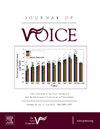甲状腺舌骨间隙触诊是诊断语音障碍的可靠和有用的临床工具吗?
IF 2.4
4区 医学
Q1 AUDIOLOGY & SPEECH-LANGUAGE PATHOLOGY
引用次数: 0
摘要
目的喉外肌触诊是耳鼻喉科医生和语言病理学家对出现声音抱怨的个体进行检查的常见部分,被认为有助于诊断和治疗计划。虽然研究已经确定了甲状腺舌骨张力和功能亢进的声音障碍之间的重要关系,但我们还没有发现任何研究探索触诊时甲状腺舌骨姿势与全谱声音障碍之间的相关性。本研究旨在确定休息和发声时甲状腺舌骨姿势的模式是否与频闪检查结果和语音障碍诊断有关。方法由3名喉科医师和3名语言病理学家组成的多学科团队对47例因语音投诉就诊的新患者进行数据收集。每位患者在休息和发音时均由两名独立评分者进行颈部触诊和甲状腺舌骨间隙评估。临床医生随后使用频闪检查评估声门关闭和声门上活动,作为确定初步诊断的一部分。结果在休息时(κ = 0.93)和发音时(κ = 0.80)对甲状舌骨间隙姿势的评分具有较强的一致性。结果显示甲状腺舌骨位型与喉镜检查结果或原发性诊断无显著相关性。结论本文所提出的喉触诊法是一种可靠的评估甲状腺舌骨静止和发声时体位的方法。触诊评分与其他收集的指标之间缺乏显著相关性,表明这种触诊方法不是预测喉镜检查结果或声音诊断的有用工具。喉触诊仍可用于预测喉外肌张力和指导治疗计划;然而,需要进一步的研究来探索喉触诊作为外源性喉肌张力测量的有效性,以及包括患者报告的测量和甲状腺舌骨姿势随时间的重复测量的研究,以探索甲状腺舌骨姿势是否受到其他因素的影响。本文章由计算机程序翻译,如有差异,请以英文原文为准。
Is Thyrohyoid Space Palpation a Reliable and Useful Clinical Tool Within Diagnostic Protocol for Voice Disorders?
Objectives
Palpation of the extrinsic laryngeal muscles is a common part of examination performed by otolaryngologists and speech-language pathologists on individuals presenting with voice complaints, thought to aid in diagnosis and treatment planning. While research has identified a significant relationship between thyrohyoid tension and hyperfunctional voice disorders, we are not aware of any studies exploring correlations between thyrohyoid posture during palpation and the full spectrum of voice disorders. This study aims to identify whether patterns in thyrohyoid posture at rest and during phonation can be related to stroboscopic findings and voice disorder diagnoses.
Methods
A multidisciplinary team of three laryngologists and three speech-language pathologists participated in data collection during 47 new patient visits for voice complaints. Each patient underwent neck palpation and evaluation of thyrohyoid space at rest and during phonation by two independent raters. Clinicians then used stroboscopy to rate glottal closure and supraglottic activity as part of determining primary diagnosis.
Results
Strong inter-rater agreement was found for ratings of thyrohyoid space posture both at rest (κ = 0.93) and during phonation (κ = 0.80). Findings revealed no significant correlations between patterns of thyrohyoid posture and laryngoscopic findings or primary diagnoses.
Conclusions
Findings suggest that the presented method of laryngeal palpation is a reliable measure for assessing thyrohyoid posture at rest and during phonation. Lack of significant correlation between palpation ratings and other collected measures suggests that this method of palpation is not a useful tool for predicting laryngoscopic findings or voice diagnoses. Laryngeal palpation may still be useful in predicting extrinsic laryngeal muscle tension and guiding treatment planning; however, further research exploring the validity of laryngeal palpation as a measure of extrinsic laryngeal muscle tension is needed, as well as studies that include patient-reported measures and repeated measurements of thyrohyoid posture over time to explore whether thyrohyoid posture is impacted by other factors.
求助全文
通过发布文献求助,成功后即可免费获取论文全文。
去求助
来源期刊

Journal of Voice
医学-耳鼻喉科学
CiteScore
4.00
自引率
13.60%
发文量
395
审稿时长
59 days
期刊介绍:
The Journal of Voice is widely regarded as the world''s premiere journal for voice medicine and research. This peer-reviewed publication is listed in Index Medicus and is indexed by the Institute for Scientific Information. The journal contains articles written by experts throughout the world on all topics in voice sciences, voice medicine and surgery, and speech-language pathologists'' management of voice-related problems. The journal includes clinical articles, clinical research, and laboratory research. Members of the Foundation receive the journal as a benefit of membership.
 求助内容:
求助内容: 应助结果提醒方式:
应助结果提醒方式:


